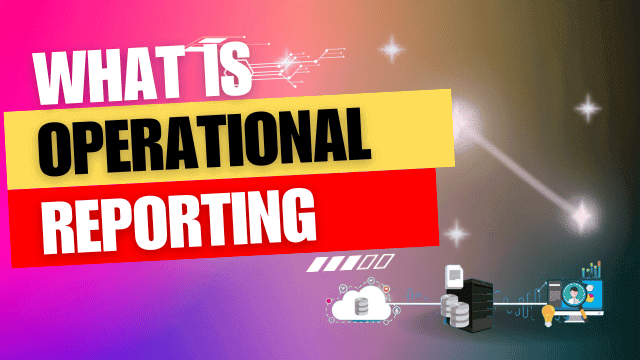
Operational reporting is a crucial aspect of business intelligence that involves the process of collecting, analyzing, and presenting data to support day-to-day operations within an organization. It provides insights into various operational aspects such as sales performance, inventory levels, customer service metrics, and more. Essentially, operational reporting helps businesses understand their current performance and make informed decisions to improve efficiency and productivity.
Key Components of Operational Reporting
Operational reporting comprises several key components, including data collection, analysis, report generation, and visualization. With these cool Airbnb basements as a guide, here are a few things to keep in mind
Data collection involves gathering relevant data from various sources such as transactional databases, ERP systems, CRM platforms, and external sources like market research reports.
Data analysis entails processing and interpreting the collected data to extract meaningful insights. This may involve using statistical techniques, data mining algorithms, and other analytical methods to uncover patterns, trends, and correlations within the data.
Report generation is the process of transforming analyzed data into comprehensive reports or dashboards. These reports typically include key performance indicators (KPIs), metrics, charts, and graphs that provide a clear snapshot of operational performance.
Visualization plays a crucial role in operational reporting by presenting data in a visually appealing and easy-to-understand format. This could involve using charts, graphs, heat maps, and other visualization techniques to highlight trends, outliers, and anomalies in the data.
Benefits of Operational Reporting
Operational reporting offers several benefits to organizations, including:
- Decision-making support: By providing timely and accurate insights, operational reporting helps business leaders make informed decisions that drive growth and profitability.
- Performance monitoring: It allows organizations to track key performance metrics in real-time and identify areas for improvement or optimization.
- Process optimization: Operational reporting enables businesses to identify inefficiencies, streamline processes, and allocate resources more effectively, leading to cost savings and enhanced productivity.
Common Challenges in Operational Reporting
Despite its benefits, operational reporting also presents some challenges, such as:
- Data accuracy and consistency: Ensuring the accuracy and consistency of data across multiple sources can be challenging, particularly in large organizations with complex data ecosystems.
- Timeliness of reporting: Delays in data collection, analysis, or reporting can hinder the effectiveness of operational reporting and impact decision-making.
- Integration of diverse data sources: Integrating data from disparate sources such as legacy systems, cloud applications, and IoT devices can be complex and time-consuming.
Best Practices for Effective Operational Reporting
To overcome these challenges and maximize the value of operational reporting, organizations can adopt the following best practices:
- Establish clear objectives: Clearly define the goals and objectives of operational reporting initiatives to ensure alignment with business priorities and stakeholder needs.
- Utilize automation tools: Leverage automation tools and technologies to streamline data collection, analysis, and report generation processes, reducing manual effort and improving efficiency.
- Ensure data quality: Implement data quality management processes and procedures to ensure the accuracy, completeness, and consistency of data used in operational reporting.
- Foster collaboration between departments: Encourage collaboration and communication between different departments and teams involved in operational reporting to facilitate knowledge sharing and cross-functional insights.
Operational Reporting Tools and Software
There are several operational reporting tools and software available in the market, each offering a range of features and capabilities to support different reporting needs. Some popular examples include Microsoft Power BI, Tableau, QlikView, and Google Data Studio. When evaluating reporting tools, organizations should consider factors such as ease of use, scalability, integration capabilities, and cost-effectiveness.
Case Studies: Successful Implementation of Operational Reporting
Several organizations have successfully implemented operational reporting initiatives to achieve tangible business benefits. For example:
- Company A: Company A implemented an operational reporting solution to streamline its inventory management processes. By analyzing inventory levels, stock turnover rates, and supplier performance metrics in real-time, the company was able to optimize its inventory levels, reduce carrying costs, and improve order fulfillment efficiency.
- Company B: Company B deployed operational reporting tools to enhance its customer service operations. By tracking key customer service metrics such as response times, resolution rates, and customer satisfaction scores, the company was able to identify service bottlenecks, allocate resources more effectively, and improve overall customer satisfaction.
Future Trends in Operational Reporting
Looking ahead, several trends are shaping the future of operational reporting, including:
- AI and machine learning integration: The integration of AI and machine learning technologies into operational reporting tools enables advanced analytics, predictive modeling, and automated insights generation, allowing organizations to uncover deeper insights and make more accurate predictions.
- Real-time reporting capabilities: With the increasing demand for real-time insights, operational reporting tools are evolving to provide faster data processing and reporting capabilities, enabling businesses to monitor performance metrics and respond to changes in real-time.
- Enhanced predictive analytics: Operational reporting is moving beyond descriptive analytics to include predictive and prescriptive analytics capabilities, allowing organizations to anticipate future trends, identify potential risks, and proactively address operational challenges.
Conclusion
In conclusion, operational reporting plays a vital role in helping organizations monitor performance, make informed decisions, and drive business growth. By leveraging data collection, analysis, and visualization techniques, businesses can gain valuable insights into their operations and optimize processes for greater efficiency and productivity.



